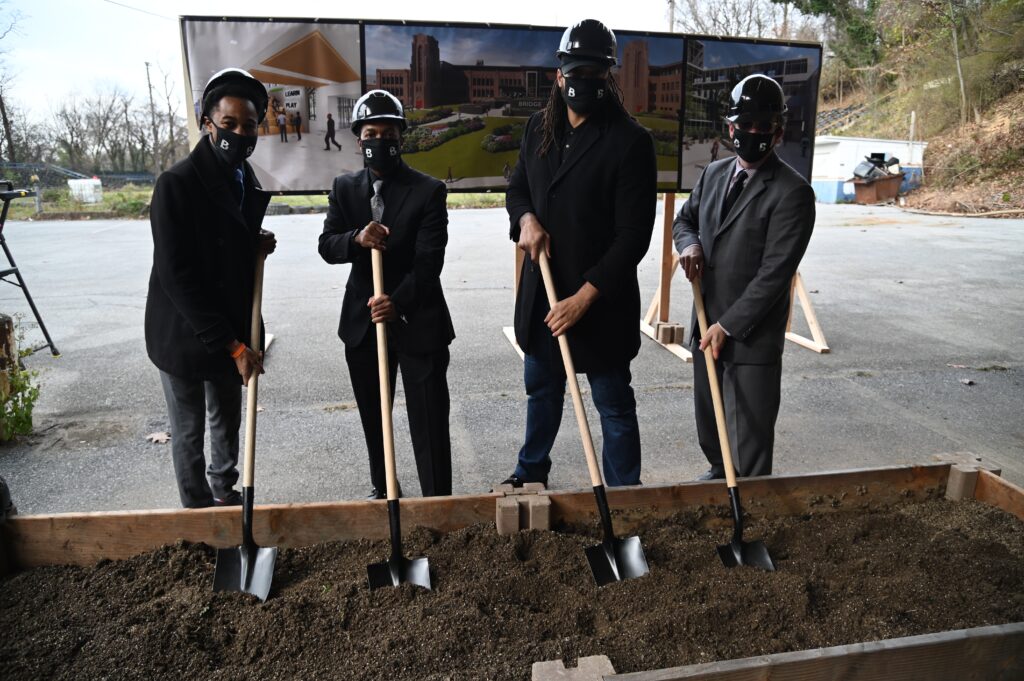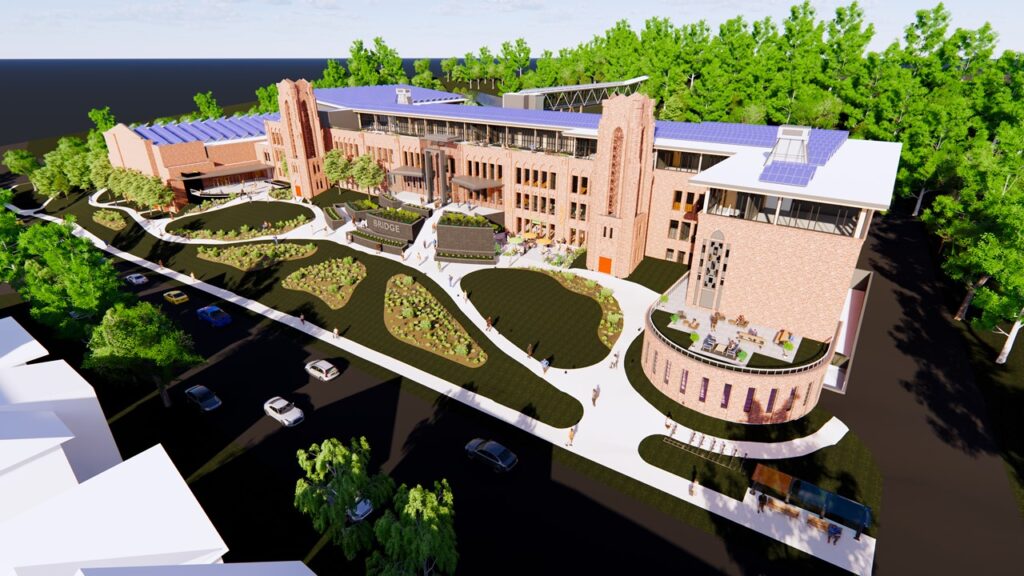When Garry Gilliam and Corey Dupree were students at the Milton Hershey School, they were amazed by the philanthropic reach of the town founder and chocolate magnate. Provided with a chance to better their lives, they wondered why there weren’t similar opportunities across the United States.
Milton Hershey School was founded in 1909 by Milton Hershey and his wife Catherine as a private boarding school for K-12 students with a focus on agricultural and vocational training. According to the school’s website, the lives of more than 10,000 children from low-income families have been transformed through high-quality education and a structured home life.
“What about all of these other major companies?” says Gilliam. “Why didn’t they do what Milton Hershey did? Not only create a town for his workers but also develop an amazing school with a great endowment. And why aren’t there more environments like this that are providing opportunities for the people who really need them?”

“We would sit at that high school and talk about how crazy it is that no other schools like Milton Hershey exist,” adds Dupree. “It was mind blowing that these multi-million dollar organizations speak about philanthropy but nobody is really doing this type of work except at this small school in Central PA.”
After graduating from Penn State University, the childhood friends parted ways. Gilliam played five seasons in the National Football League while Dupree worked as a journalist and a sports agent.
During his pro football career, Gilliam incubated several business plans, including one for a project known as The Bridge. Then a tragic death propelled him to action: In 2019, rap star and community activist Nipsey Hussle was shot and killed in front of his Marathon clothing store in the Crenshaw section of Los Angeles.
“What Nipsey did for his community really inspired me,” explains Gilliam. “I wanted to give back to my community just like he did in his.”
We’re super excited to take care of home first, and that people from all around the world will be able to see that the first Bridge location was here in Harrisburg.Garry Gilliam
The Bridge’s mission is to revitalize underserved neighborhoods by transforming abandoned properties such as schools, shopping centers and warehouses into sustainable, mixed-use developments. Each “eco-village” will contain housing units, retail shops, co-working spaces, urban agriculture, education centers, and medical and entertainment facilities.
The Bridge’s first project is to repurpose the 115,000-square-foot former Bishop McDevitt High School in Harrisburg. It’s the city where Gilliam was born, Dupree now lives, and their company is based.
“We really kind of stumbled upon McDevitt,” says Gilliam, who is chief executive officer. “It wasn’t on the market and actually was in the process of working through a contract to be developed. We spoke with that team, and shared our vision and what we wanted to do. [We] said, ‘Look, this will really help Harrisburg and we’d like to work with you guys to get this thing going.’”
The company’s second project will be a renovation of the former William Penn High School into a Bridge, but the founders’ vision extends well beyond Harrisburg. Dupree, the company’s chief operations officer, says they plan to implement an aggressive expansion plan into Philadelphia, Pittsburgh, Atlanta, Cleveland, Detroit, Houston and Seattle in the coming years.

“We’re super excited to take care of home first, and that people from all around the world will be able to see that the first Bridge location was here in Harrisburg,” he says. “And then we will rinse and repeat.”
The Bridge has been building partnerships with people all over the world with people who share the goal of offering life-altering chances to people who have been oppressed.
“We’ve reached out to people in Africa, we’ve reached out to people in California, in Europe,” says Dupree. “And we know that it doesn’t just exist here within our own pocket of Harrisburg, but literally around the world. So, for me, that’s part of my passion as we are in the process of creating a new system that combats the systemic oppression that exists everywhere.”
After taking possession of the McDevitt property in 2019, Gilliam and Dupree focused on determining what type of development that would best serve Harrisburg residents.
The lives that will be impacted through our organization, these facilities and through these programs really can’t be put into numbers.Corey Dupree
“It’s not a cookie cutter type thing,” says Gilliam. “Once [we took possession], it was about getting our boots on the ground and talking to the community, local political leaders, nonprofits, different companies and different stakeholders that will utilize this space, that have ideas for this space.”
“The programs, the actual uses, will be determined by the community,” adds Gilliam. “That was first and foremost in our minds because a Bridge design for the Allison Hill [neighborhood] is completely different from a Bridge design for Uptown Harrisburg. The needs are similar but the specifics are different.”
Based those conversations, a majority of the main building will contain commercial spaces; the old gymnasium will be converted into “The Hub.”
“The main building is where we will house all of the nonprofits, all the different programs, all the different things we plan to offer like credit repair, incubation and acceleration for businesses, a food prep kitchen, a pop-up medical clinic and a food market,” says Gilliam. “Behind the main building, there will be low-income and market-rate housing towers that will be built. Right now, it’s looking like there will be a total of 120 units with everything slated to be finished by [late] 2023.”
The main building will also house The Bridge’s corporate offices.
Because their business is focused on commercial real estate, there may be future investment opportunities for individuals interested in supporting the work of The Bridge.

“It’s important to understand that ROI isn’t just Return on Investment but, more importantly, Return on Impact,” says Dupree. “The lives that will be impacted through our organization, these facilities and through these programs really can’t be put into numbers. The reality of the situation is that when you have these inequities — for example, where math and reading scores in Harrisburg are at 14 and 17 percent and, 15 miles down the road in Hershey, they are at 80 and 90 percent — there are clearly inequities that must be addressed.”
The Bridge aims to address educational inequality, food insecurity (which is tied to obesity and other health issues like diabetes), home occupancy rates, employment opportunities, and income equality.
“There’s a huge need across the country, no doubt, and I think 2020 really magnified a bunch of different needs,” says Gilliam. “Obviously the social and racial tension that’s across the country, and as we talk about the health conditions that COVID really ramped up, those things are really built into food localization and food security.”
That’s why the outdoor space at the McDevitt Bridge will contain a vertical garden.
“Growing our food closer to where we really need it is important,” says Gilliam. “With housing and commercial spaces…self sufficiency should be our number one priority, not only for ourselves but in our communities.”
JAMES MENTZER is president of Mentzer Communications LLC and a freelance writer who is the author of three books, including Pennsylvania Manufacturing: Alive and Well. He resides in Harrisburg.
Lead Image: Left to Right: Jordan Hill, Garry Gilliam, and DeZwaan Dubois
